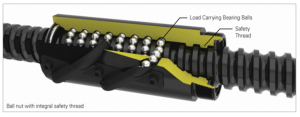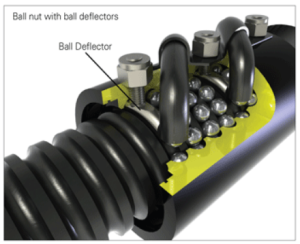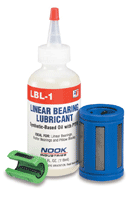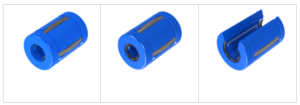Ball nuts can fail for a variety of reasons. Primarily, it’s fatigue of the bearing balls or the threaded surface, which is why proper lubrication (link to lube blog post) is so important. However, ball nuts can fail prematurely due to misalignment, impact loading, contamination, or external damage to the return circuits. Premature failure may result in the loss of some or all of the balls between the nut and screw. When all the balls are lost the nut is no longer engaged with the screw and therefore may not move when the screw is rotated or, in vertical applications, will free fall along the screw.
In applications where this loss of ball type failure could result in injury or death, this failure needs to be considered in the design. Possible preventative measures include the use of two or more screws supporting the load, use of nuts with multiple independent ball recirculation circuits, use of Ball Deflectors which prevent the balls from exiting the ball nut out the ends.
There is one more preventative measure that has proven itself in testing and in practical use; Integral Safety Threads. These unique solutions that provide the ball nut with a secondary safety thread – a reverse thread in the nut body itself. This special thread extends from the ID (Internal Diameter) of the nut to below the OD (Outside Diameter) of the screw without making contact. In the unlikely event that all the balls in the nut are lost, this “safety” thread will engage the screw and prevent free-fall. Although this thread can be used to lower the load to a safe position, it is not to be used otherwise. This can also be accomplished with the use of a special flange if the ball nut body cannot accommodate the Safety Thread feature.





